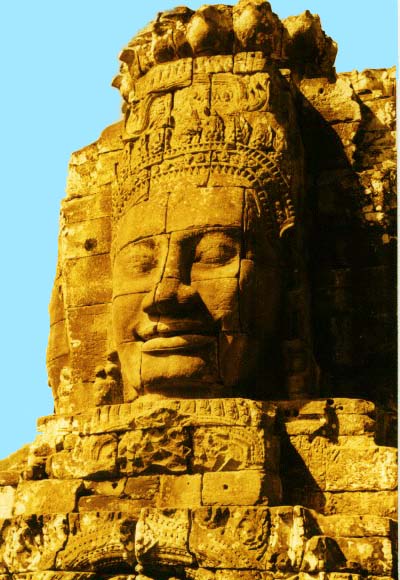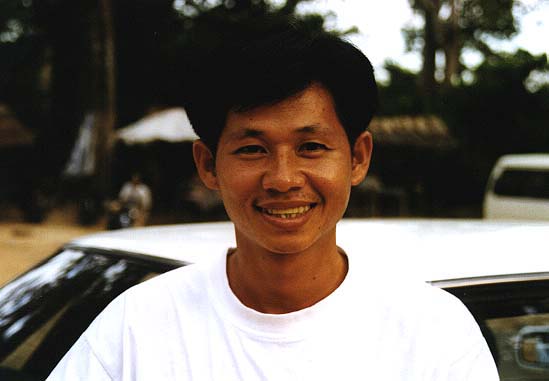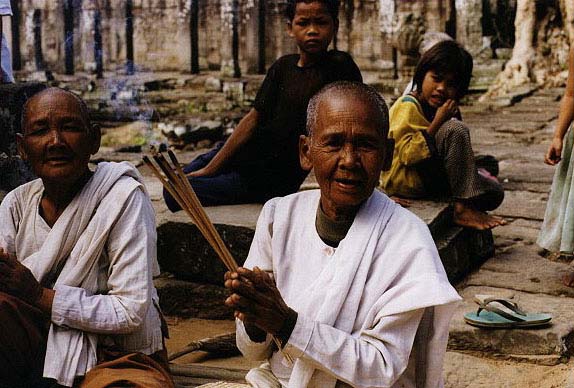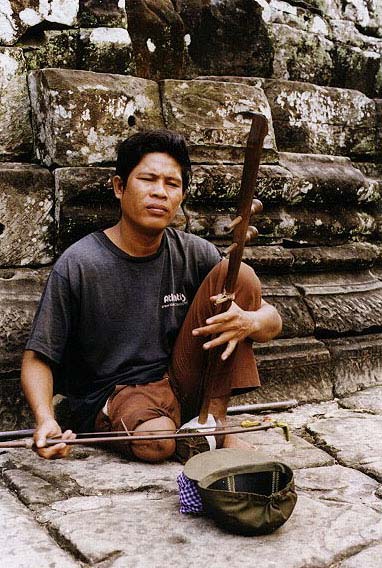
Faces of the Jungle
 |
| Avelokitesvara head, the Bayon |
Jungle Green... Rice Paddy Green... There are no crayons in the Crayola box that can express the depth of these colors. Angkor is covered in green, surrounded by it. Green creeps into the ruins, between the rocks, up stone towers.
is covered in green, surrounded by it. Green creeps into the ruins, between the rocks, up stone towers.
From the window of our Royal Air Cambodge flight I could see the vast green expanses of Siem Reap, the city closest to the ruins. Our plane touched down in Siem Reap at 7:15 AM. A mob of men stood at the airport door offering guides or taxis. Andy walked headlong into the mob and pointed to one man. Later Andy explained half-seriously that to me that he'd selected this man out of the crowd because he was the smallest. If he tried to hurt us, Andy figured he could take him. We were still feeling paranoid and overly cautious. The man Andy chose grabbed his wrist and led us through the crowd to his car.
"My brother," the man said pointing to the driver. "Do you need a guide at Angkor? My brother will take you everywhere."
"How much?" We asked.
"Twenty dollars a day," he said.
Twenty dollars was the going rate, so we agreed. We gave the man the fee for tickets into Angkor - $40 each. As was the case in Phnom Penh, the US dollar is the preferred currency here. He dropped us off at our hotel, The Golden Apsara, then went off to buy our tickets. The hotel was nice. A good bathroom with plenty of toilet paper. Three beds, each a little wider than your average dorm room bed. A balcony, air conditioning, nice paintings of Angkor Wat in the hallway, and orange curtains, almost the shade of a monk's saffron robe. A cat perched on the rooftop of the next building over. Geckos scurried around on the balcony. The hotel manager only spoke French, which actually gave me an opportunity to use my seventh grade French.
 |
| Rang, our driver and guide to Angkor Interested in hiring Rang next time you're at Angkor? |
Angkor is about 15 minutes away from the hotel, and the drive brought us straight through the heart of the city. Siem Reap is much calmer than Phnom Penh and much smaller, more like a village than a city. One of Sihanouk's palaces dominates the center of town. Huge paintings of the king are set on the street corners. Red and blue banners decorated with the white outline of Angkor Wat stream across the road sides. Mopeds and bicycles make up about 90% of the local traffic. As was the case in the capital, there are no street lights to dictate the flow of vehicles. School children, stray dogs, and roosters sidestep mopeds on dirt roads. Homes and merchant stalls line the river banks.
The first structure that welcomed us to Angkor was the south gate of Angkor Thom. It is a huge archway crowned with four smiling faces, each looking out on a different north, south, east, west direction. The stone gate is twenty meters tall. It is an imposing introduction, but the mysterious smiles on the four heads of the Avalokiteshvara are welcoming. Under the green shades of the forest, the grin looks peaceful.
are welcoming. Under the green shades of the forest, the grin looks peaceful.
 |
| Angkor Thom south gate |
 remind me that this too was the front-line. But today it is so peaceful. Children climb on the ruins as if they were in an enormous playground. If Phnom Penh is like a city of children, then Angkor is like a land of children. At every turn they hang out, play, run, try to sell their wares to tourists. They bombarded us with flutes, T-shirts, wooden boats, film. We were surrounded by child merchants. Adults sell film and water, but the overwhelming majority of people at Angkor are under 17.
remind me that this too was the front-line. But today it is so peaceful. Children climb on the ruins as if they were in an enormous playground. If Phnom Penh is like a city of children, then Angkor is like a land of children. At every turn they hang out, play, run, try to sell their wares to tourists. They bombarded us with flutes, T-shirts, wooden boats, film. We were surrounded by child merchants. Adults sell film and water, but the overwhelming majority of people at Angkor are under 17. As we drove up to the stone gate, I was immediately awed by the beauty of this place. In all my travels, I have never seen anything that rivals the majesty, the aura of Angkor. The war did not destroy it. Like the people here, Angkor is an enduring witness. Land mines have been cleared from the area. Restoration is in progress. Bamboo scaffolding supports some of the ruins. Angkor is a rugged survivor. Angkor has withstood a thousand years of time and four years of the Khmer Rouge, yet it is still quite clearly one of the wonders of the world.
The kingdom of Angkor rose, thrived and collapsed between 802 AD and 1432 AD. For the first several hundred years, Hindu tradition dictated the layout of the stone structures, as they were designed to emulate the mythical Mount Meru. After 1181, most of the kings (and so too the monuments) were Buddhist. Angkor reached its height in the late 12th and early 13th centuries when some 750,000 people lived here. But after suffering two defeats to the Thai army, the Khmer court abandoned the city for Phnom Penh. Vines moved in. Trees dug their roots into the ruins. The jungle encroached upon the massive gray stones. Jungle Green ... Rice Paddy Green... crept through this magnificent ghost town.
After 1181, most of the kings (and so too the monuments) were Buddhist. Angkor reached its height in the late 12th and early 13th centuries when some 750,000 people lived here. But after suffering two defeats to the Thai army, the Khmer court abandoned the city for Phnom Penh. Vines moved in. Trees dug their roots into the ruins. The jungle encroached upon the massive gray stones. Jungle Green ... Rice Paddy Green... crept through this magnificent ghost town.






